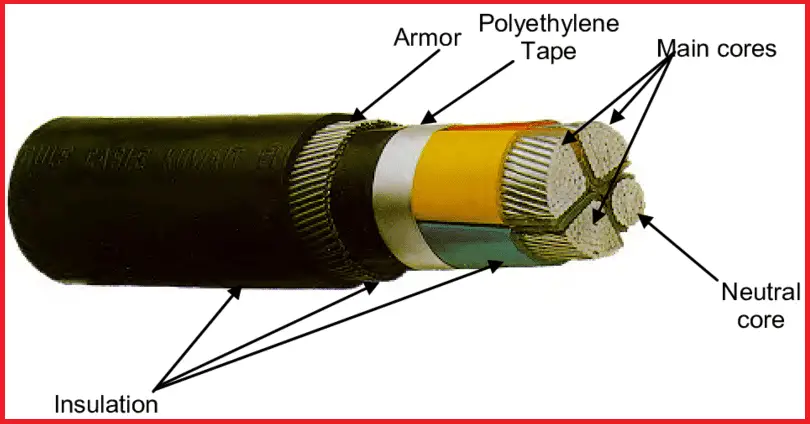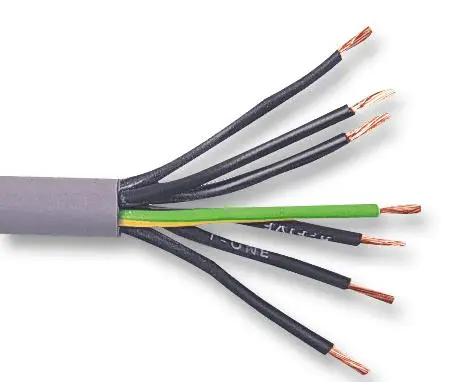This article describes the difference between power cables and control cables. Depending on the use of cables based on energy transmission, they can be classified into
- Power Cable
- Control Cable

Power cables and Control cables are quite almost similar to one another. Both power and control cables are utilized in electrical power generation and industrial environments. These cables are similar to each other in some aspects and at times have a lot of differences. Both types of cables for power and control applications are constructed with XLPE, PVC, PE, single and multi-conductor, sheathed or steel-wire armored, and jacket.
Power cables are cables that transfer both high and low energies from their source to equipment (located at various places in need).
Types of Electrical Cable
Depending on the transmission system, the electrical cables can be alternating current or direct current. AC cables are used in 50 Hertz (frequency) home systems. Power loss during DC transmission is very low when DC cables are used. This article will discuss the main difference between power and control cables.
What is Power Cable? And its importance?
The term electrical cable is also known as an electrical cable. Electrical power is distributed and transmitted by using power cables. A power cable is the type of cable used to transmit power from its source to devices.

They are also used in the internal supplies of power and manufacturing industrial establishments.
Power cables are used for overhead, marine, and underground transmissions, as well as in industrial environments. These are multi-core cables with aluminum or copper conductors.
What is Control Cable?
In instrumentation, the control cable is a cable that connects various field devices from the control room. Its source may be of single controller, PLC or DCS, FGS, etc., systems. Control cables are designed for automation control, for sending signals from the control device, as well as for measurement and regulation.

Multicore control cables from the marshaling cabinets of the control room pass the junction boxes and get divided into individual single-core cables to connect field instruments such as transmitters, control valves, etc. This cable must be flexible or bendable due to the environment in which it will be used.
These are multi-conductor cables containing conductors of small diameters. Due to their excellent electrical conductivity, they are more often available with copper conductors.
Terms such as Control, Instrumentation, and signaling
The terms control, instrumentation, and signaling refer to cables that transport low levels of energy but do not carry high electrical power. However, there are slight differences between the words, control and electrical.
An example of signal cables is coaxial cables, fiber optic (OFC), and twisted pair cables. The signal cable is similar to the control cable in that both transmit signals. Signal cables, however, carry data. They, therefore, require shielding to avoid electromagnetic interference (EMI). Conventional control cables are not always shielded.
Cables used in instrumentation are also commonly referred to as control cables. “Control” and “instrumentation:” are sometimes used interchangeably to describe the same cable. With this, it is clear that the functions of instrumentation and control are interconnected.
Difference between Power and Control cable
There are some specific differences between the power and control cables. Unlike control cables, power cables are generally identified with different color codes to distinguish the difference between high and low-power carriers.
Functional difference
Control cables are mainly used for power transmission from distribution points to various electrical and instrumentation equipment.
Power cables are the backbone of the electrical system for large-operating power transmission and distribution. High energy and low energy are transferred from the source to the equipment. These power cables are used on the main lines of the power system for transmission and distribution of power at all voltage levels from 1 to 500 kV and above.
The current flowing through the power cable is much higher than that of the control cable. Control cables are available with a minimum cross-section of 0.75 mm2 and voltage class 300V/500V. On the other hand, the cross-sectional area of the power cable is several times bigger (up to 630 mm2) than the control cables.
The control cables are used to directly transmit the electrical energy from the power distribution point to the different electrical equipment and appliances. On the other hand, power cables are widely used in power generation, distribution, transmission, transformation, and power supply lines.
Difference in Shielding
Control cables offer superior resistance to interference (signal noise). Therefore, control cables are ideal for sending low-voltage signals and power cables are capable of transferring higher energy. During control cable laying a gap of 0.2 meters with electrical cables is essential to overcome electromagnetic interference (EMI) effects.
A power cable is used to transmit and distribute the power of large functions in the main line of the power system. Whereas, control cables are used for the purposes of measurement, control, and automation.
Difference in the number of cores
Power cables have a less number of cores. They are usually single-core, 2-core, and up to 5-core. Control cables transmit control signals. Therefore, control cables have more cores, from 2 to 24 cores, or even more.
Control cables also used various core constructions, shields, and other measures to prevent electromagnetic interference.
Insulation and coating
In the case of power cables, there are often requirements for resistance to compression, traction, temperature, and corrosion. In contrast, the control cable requirements are relatively low. Therefore, the insulation and sheath of the power cables are usually thicker than the control cable.
Since power cables are used in an active environment and transmit a lot of energy, they require excellent sheathing. In power cables, the sheath is robust and resists a variety of external factors including corrosion and temperature. Control cables do not require the same sheath and usually have conventional PVC insulation.
A wonderful information, as the difference between control cable and signal cable’s narative is precise in this article..